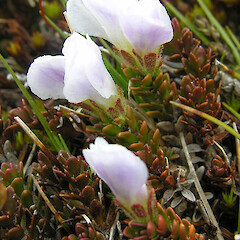Veronica trifida
Common name
hebejeebie
Synonyms
Parahebe trifida (Petrie) W.R.B.Oliv., Hebejeebie trifida (Petrie) Heads
Family
Plantaginaceae
Flora category
Vascular – Native
Endemic taxon
Yes
Endemic genus
No
Endemic family
No
Structural class
Herbs - Dicotyledons other than Composites
NVS code
The National Vegetation Survey (NVS) Databank is a physical archive and electronic databank containing records of over 94,000 vegetation survey plots - including data from over 19,000 permanent plots. NVS maintains a standard set of species code abbreviations that correspond to standard scientific plant names from the Ngä Tipu o Aotearoa - New Zealand Plants database.
PARTRI
Chromosome number
2n = 42
Current conservation status
The conservation status of all known New Zealand vascular plant taxa at the rank of species and below were reassessed in 2017 using the New Zealand Threat Classification System (NZTCS) – more information about this can be found on the NZTCS website. This report includes a statistical summary and brief notes on changes since 2012 and replaces all previous NZTCS lists for vascular plants.
Please note, threat classifications are often suggested by authors when publications fall between NZTCS assessment periods – an interim threat classification status has not been assessed by the NZTCS panel.
- Conservation status of New Zealand indigenous vascular plants, 2017 . 2018. Peter J. de Lange, Jeremy R. Rolfe, John W. Barkla, Shannel P. Courtney, Paul D. Champion, Leon R. Perrie, Sarah M. Beadel, Kerry A. Ford, Ilse Breitwieser, Ines Schönberger, Rowan Hindmarsh-Walls, Peter B. Heenan and Kate Ladley. Department of Conservation. Source: NZTCS and licensed by DOC for reuse under the Creative Commons Attribution 4.0 International licence.
2017 | At Risk – Naturally Uncommon | Qualifiers: RR, Sp
Previous conservation statuses
2012 | At Risk – Naturally Uncommon | Qualifiers: RR, Sp
2009 | At Risk – Naturally Uncommon
2004 | Not Threatened
Distribution
Endemic. New Zealand: South Island (Central Otago and Southland).
Habitat
Alpine in seepages and flushes of meltwater below summer snowbanks, and along edges of water races, or in boggy ground.
Detailed description
Subshrub, 50-200 mm tall. Old stems brown or grey. Branches prostrate to ascending. Branchlets brown or purplish. Vegetative internodes 1-5 mm long. Stems uniformly pubescent hairs uniform, retrorse-appressed, eglandular. Leaves decussate or subdistichous, erecto-patent. Lamina oblanceolate or obovate or oblong or elliptic or spathulate or orbicular (rarely), 2-10 × 1-7 mm. Upper surface of leaves green or bronze green, glossy. Under surface of leaves green or bronze green or purple, glossy. Leaf hairs sparse to scattered or absent, along margins and on petiole, uniseriate glandular with globular head. Apex subacute or obtuse or rounded. Base cuneate. Margin minutely papillate, glandular-ciliate, and ciliate (rarely), rarely entire or crenate or serrate or lobed. Marginal teeth or lobes in 0-3 pairs. Petiole 1-2 mm long. Inflorescence of 1-2 flowers, 15-25 mm long at fruiting. Indumentum of peduncle, rachis, and pedicels moderately dense to very dense. Eglandular hairs of inflorescence deflexed (glandular hairs patent), white. Peduncle 2-10 mm long, eglandular-pubescent and glandular-pubescent; hairs all around peduncle. Rachis 20-50 mm long, eglandular-pubescent and glandular-pubescent, hairs all around rachis. Bracts alternate or paired and opposite, subacute or acute, glandular ciliate, glandular pubescent abaxially, and glandular pubescent adaxially (sparse or absent), elliptic or obovate. Bract margins entire. Pedicels suberect at anthesis, straight at fruiting, 0.5-7.0 mm long, eglandular-pubescent and glandular-pubescent; hairs all around pedicel. Flowers: Calyx 4-lobed, 5-8 mm long. Calyx lobes oblanceolate or spathulate, subacute or obtuse. Calyx hairs on both abaxial and adaxial surfaces, mixed eglandular and mostly glandular. Calyx lobe margins entire. Corolla white at anthesis or mauve at anthesis (rarely). Nectar guides absent. Corolla throat yellow. Corolla 15–20 mm diameter Corolla tube 1.5-3.0 mm long, 1.5-2.0 mm wide, glabrous. Corolla lobes glabrous. Posterior corolla lobe elliptic or obovate, obtuse, 8-10 × 4-7 mm. Lateral corolla lobes elliptic or obovate, obtuse, flat, not enfolding stamens, 8-10 × 4-7 mm. Anterior corolla lobe elliptic or obovate, obtuse, 8-10 × 3-6 mm. Stamen filaments white, 3-4 mm long, not narrowed at base. Anthers mauve to purple, 1.0-1.5 mm long. Nectarial disc glabrous. Ovary ellipsoid, acute, glabrous or glandular hairy (sparsely at apex), 2.0-2.5 mm long. Style 3-4 mm long. Stigma 0.3–0.5 mm wide. Capsules strongly flattened, emarginate 4.5-6.0 × 2.5-3.0 mm, glabrous or sparsely hairy. Hairs glandular, if present. Septicidal split of capsule extending to base. Loculicidal split of capsule extending ½ way to base. Seeds strongly flattened, smooth-surfaced, ellipsoid or obovoid, pale brown, 0.5-0.8 × 0.4-0.6 mm
Similar taxa
Allied to Veronica densiflora, V. birleyi and V. spectabilis, from which V. trifida differs by the glossy bright green, bronze-green or purple tinged rather than dull dark green or purplish leaves.
Flowering
October - December
Flower colours
Violet/Purple, White
Fruiting
December - April
Propagation technique
Difficult. Should not be removed from the wild.
Etymology
veronica: Named after Saint Veronica, who gave Jesus her veil to wipe his brow as he carried the cross through Jerusalem, perhaps because the common name of this plant is ‘speedwell’. The name Veronica is often believed to derive from the Latin vera ‘truth’ and iconica ‘image’, but it is actually derived from the Macedonian name Berenice which means ‘bearer of victory’.
trifida: Divided into three
Where To Buy
Not Commercially Available
Attribution
Fact Sheet by P.J. de Lange (5 October 2006). Description adapted from Garnock-Jones and Lloyd (2003).
References and further reading
Garnock-Jones, P.J.; Lloyd, D.G. 2003: A taxonomic revision of Parahebe (Plantaginaceae) in New Zealand. New Zealand Journal of Botany 42: 181-232.
NZPCN Fact Sheet citation
Please cite as: de Lange, P.J. (Year at time of access): Veronica trifida Fact Sheet (content continuously updated). New Zealand Plant Conservation Network. https://www.nzpcn.org.nz/flora/species/veronica-trifida/ (Date website was queried)





